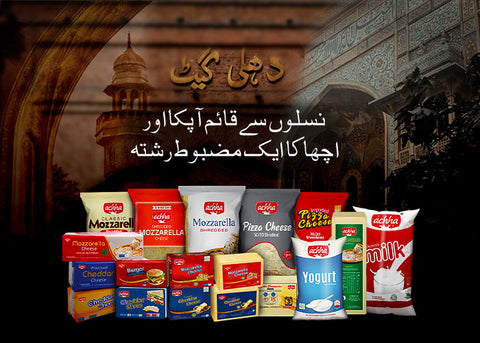The Indo-Pak subcontinent, rich in cultural and culinary heritage, has a long-standing relationship with dairy products. For centuries, dairy has been a staple in the diet and a crucial component of traditional medicine and skincare. This blog explores the historical dairy practices in this region, highlighting its uses and contributions to health and beauty.
Achha Foods and its dairy products have been a staple of fresh and quality dairy for decades. We nurtured the streets of Lahore with health, nutrition and goodness. Today we will dive into some historical essence of dairy.
Historical Dairy Practices
1. Milking and Dairy Farming
Dairy farming in the Indo-Pak subcontinent dates back to the Indus Valley Civilization (circa 2500 BCE). Cows and buffaloes were the primary sources of milk. The traditional method of hand milking was common, and the milk was often collected in clay pots to maintain its freshness. This practice continues in many rural areas today, emphasizing the importance of dairy in daily life.
Achha Foods and Dairy still use some traditional methods to attain the finest quality milk before pasteurizing.
2. Processing and Preservation
To extend the shelf life of milk, various preservation methods were employed. Boiling milk was a standard practice to prevent spoilage. Additionally, fermenting milk into yogurt and buttermilk was widespread. These fermented products were not only consumed as refreshing beverages but also used in cooking and medicinal preparations.
Achha Foods uses pasteurizing techniques to avoid spoilage. It helps in keeping the milk fresh and good for use for a while.
3. Ghee Making
Ghee, or clarified butter, holds a special place in the subcontinent's culinary and medicinal traditions. It was made by churning cream to separate butter, which was then heated to remove water content. Ghee's long shelf life and nutritional benefits made it a valuable commodity.
Achha Foods desi ghee is also made from this method to this date because we never compromise on quality and health.
Culinary Uses
1. Staple Foods
Milk, yogurt, and ghee were integral to the daily diet in the old times. Milk was consumed fresh or boiled, often with added spices for flavor and medicinal benefits. Yogurt was a common accompaniment to meals, aiding in digestion and cooling the body, especially in the hot climate.
2. Traditional Dishes
Dairy products were essential in preparing traditional dishes. For instance, kheer (a rice pudding made with milk and sugar) and paneer (Indian cheese) featured prominently in festivities and daily meals. Lassi, a yogurt-based drink, was a popular summer beverage, known for its refreshing and probiotic qualities.
3. Ayurvedic and Unani Medicine
In Ayurvedic and Unani medicine, dairy was valued for its health-promoting properties. Milk was considered a complete food, providing essential nutrients. Ghee was used in various formulations to enhance immunity, improve digestion, and treat inflammatory conditions. Buttermilk was recommended for its cooling properties and ability to balance digestive health.
Health Benefits
1. Nutritional Value
Dairy products are rich in calcium, protein, and essential vitamins such as B12 and D. These nutrients are vital for bone health, muscle function, and overall growth. The consumption of dairy in traditional diets ensured that these nutritional needs were met, contributing to the general well-being of the population.
2. Probiotic Properties
Fermented dairy products like yogurt and buttermilk are excellent probiotic sources, promoting a healthy gut microbiome. A balanced gut flora is linked to improved digestion, enhanced immune function, and better mental health.
3. Therapeutic Uses
In traditional medicine, dairy was used to treat various ailments. Warm milk with turmeric (haldi doodh) was a common remedy for colds and inflammation, known today as "golden milk." Ghee was applied to wounds and burns for its healing properties and used in massages to nourish the skin and body.
Skin and Beauty Benefits
1. Natural Moisturizer
Milk and milk cream (malai) were used as natural moisturizers. Applying malai to the skin helped to keep it soft, smooth, and hydrated. This practice was particularly popular among women to maintain a youthful complexion.
2. Cleansing and Exfoliation
Buttermilk and yogurt were used as natural cleansers and exfoliants. The lactic acid in these products gently removes dead skin cells and impurities, promoting a clear and glowing complexion. Traditional ubtan (a paste made from yogurt, turmeric, and gram flour) was a common skincare ritual for brides.
3. Anti-Aging Properties
The antioxidants and healthy fats in dairy products like ghee were believed to have anti-ageing effects. Massaging the face with ghee was a traditional practice to reduce wrinkles and maintain skin elasticity.
The rich dairy traditions of the Indo-Pak subcontinent reflect a deep understanding of the nutritional, medicinal, and cosmetic benefits of dairy products. From the farm to the kitchen and the medicine cabinet, dairy has played a vital role in the daily lives of people in this region. As modern science continues to uncover the benefits of these age-old practices, there is a renewed appreciation for the wisdom embedded in traditional dairy use. Achha Dairy supports the people of this generation in all their endeavours, whether for health, culinary delight, or beauty. The legacy of dairy in the Indo-Pak subcontinent remains a testament to its enduring value and Achha Foods tends to keep it going.




